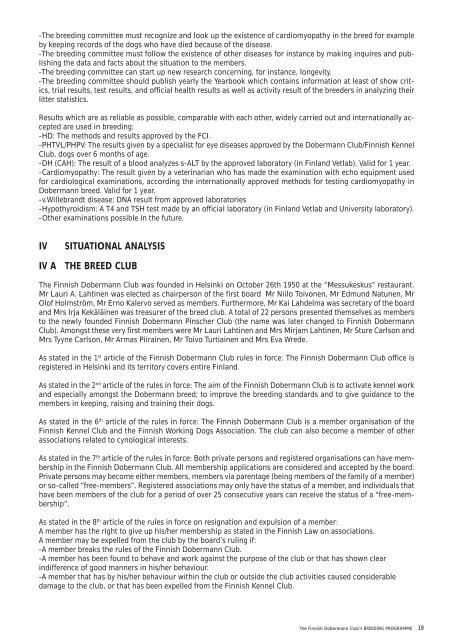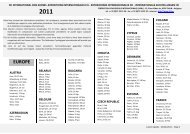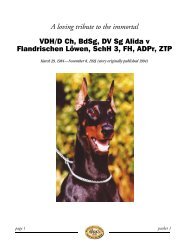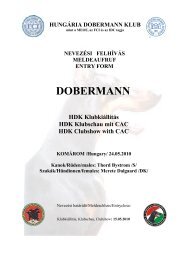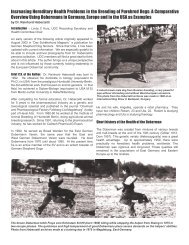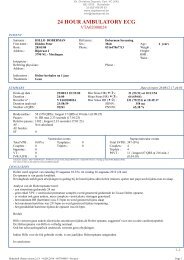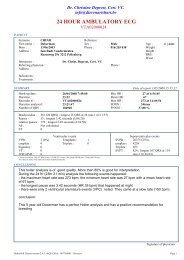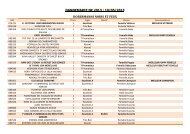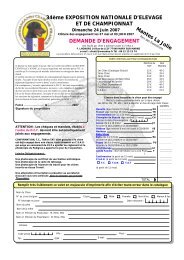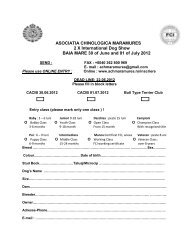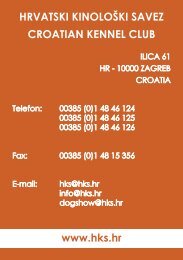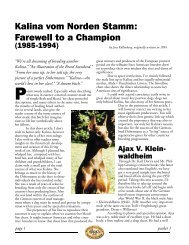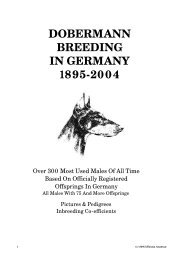Breeding Programme
Breeding Programme
Breeding Programme
You also want an ePaper? Increase the reach of your titles
YUMPU automatically turns print PDFs into web optimized ePapers that Google loves.
-The breeding committee must recognize and look up the existence of cardiomyopathy in the breed for example<br />
by keeping records of the dogs who have died because of the disease.<br />
-The breeding committee must follow the existence of other diseases for instance by making inquires and publishing<br />
the data and facts about the situation to the members.<br />
-The breeding committee can start up new research concerning, for instance, longevity.<br />
-The breeding committee should publish yearly the Yearbook which contains information at least of show critics,<br />
trial results, test results, and official health results as well as activity result of the breeders in analyzing their<br />
litter statistics.<br />
Results which are as reliable as possible, comparable with each other, widely carried out and internationally accepted<br />
are used in breeding:<br />
-HD: The methods and results approved by the FCI.<br />
-PHTVL/PHPV: The results given by a specialist for eye diseases approved by the Dobermann Club/Finnish Kennel<br />
Club, dogs over 6 months of age.<br />
-DH (CAH): The result of a blood analyzes s-ALT by the approved laboratory (in Finland Vetlab). Valid for 1 year.<br />
-Cardiomyopathy: The result given by a veterinarian who has made the examination with echo equipment used<br />
for cardiological examinations, according the internationally approved methods for testing cardiomyopathy in<br />
Dobermann breed. Valid for 1 year.<br />
-v.Willebrandt disease: DNA result from approved laboratories<br />
-Hypothyroidism: A T4 and TSH test made by an official laboratory (in Finland Vetlab and University laboratory).<br />
-Other examinations possible in the future.<br />
IV<br />
SITUATIONAL ANALYSIS<br />
IV A THE BREED CLUB<br />
The Finnish Dobermann Club was founded in Helsinki on October 26th 1950 at the “Messukeskus” restaurant.<br />
Mr Lauri A. Lahtinen was elected as chairperson of the first board Mr Niilo Toivonen, Mr Edmund Natunen, Mr<br />
Olof Holmström, Mr Erno Kalervo served as members. Furthermore, Mr Kai Lahdelma was secretary of the board<br />
and Mrs Irja Kekäläinen was treasurer of the breed club. A total of 22 persons presented themselves as members<br />
to the newly founded Finnish Dobermann Pinscher Club (the name was later changed to Finnish Dobermann<br />
Club). Amongst these very first members were Mr Lauri Lahtinen and Mrs Mirjam Lahtinen, Mr Sture Carlson and<br />
Mrs Tyyne Carlson, Mr Armas Piirainen, Mr Toivo Turtiainen and Mrs Eva Wrede.<br />
As stated in the 1 st article of the Finnish Dobermann Club rules in force: The Finnish Dobermann Club office is<br />
registered in Helsinki and its territory covers entire Finland.<br />
As stated in the 2 nd article of the rules in force: The aim of the Finnish Dobermann Club is to activate kennel work<br />
and especially amongst the Dobermann breed; to improve the breeding standards and to give guidance to the<br />
members in keeping, raising and training their dogs.<br />
As stated in the 6 th article of the rules in force: The Finnish Dobermann Club is a member organisation of the<br />
Finnish Kennel Club and the Finnish Working Dogs Association. The club can also become a member of other<br />
associations related to cynological interests.<br />
As stated in the 7 th article of the rules in force: Both private persons and registered organisations can have membership<br />
in the Finnish Dobermann Club. All membership applications are considered and accepted by the board.<br />
Private persons may become either members, members via parentage (being members of the family of a member)<br />
or so-called “free-members”. Registered associations may only have the status of a member, and individuals that<br />
have been members of the club for a period of over 25 consecutive years can receive the status of a “free-membership”.<br />
As stated in the 8 th article of the rules in force on resignation and expulsion of a member:<br />
A member has the right to give up his/her membership as stated in the Finnish Law on associations.<br />
A member may be expelled from the club by the board’s ruling if:<br />
-A member breaks the rules of the Finnish Dobermann Club.<br />
-A member has been found to behave and work against the purpose of the club or that has shown clear<br />
indifference of good manners in his/her behaviour.<br />
-A member that has by his/her behaviour within the club or outside the club activities caused considerable<br />
damage to the club, or that has been expelled from the Finnish Kennel Club.<br />
The Finnish Dobermann Club’s BREEDING PROGRAMME 19


